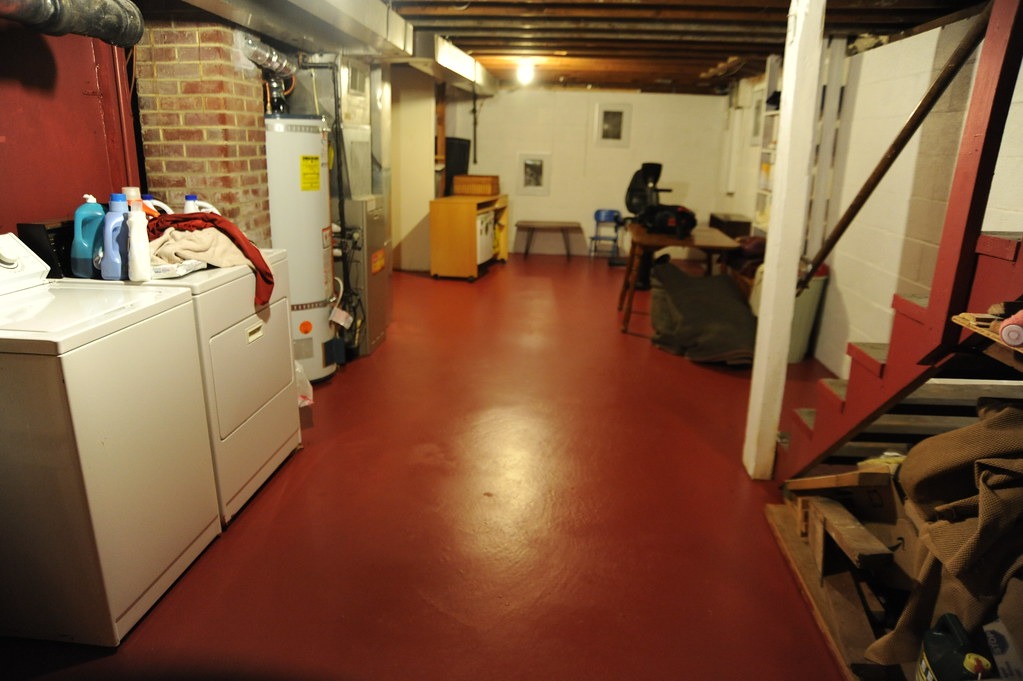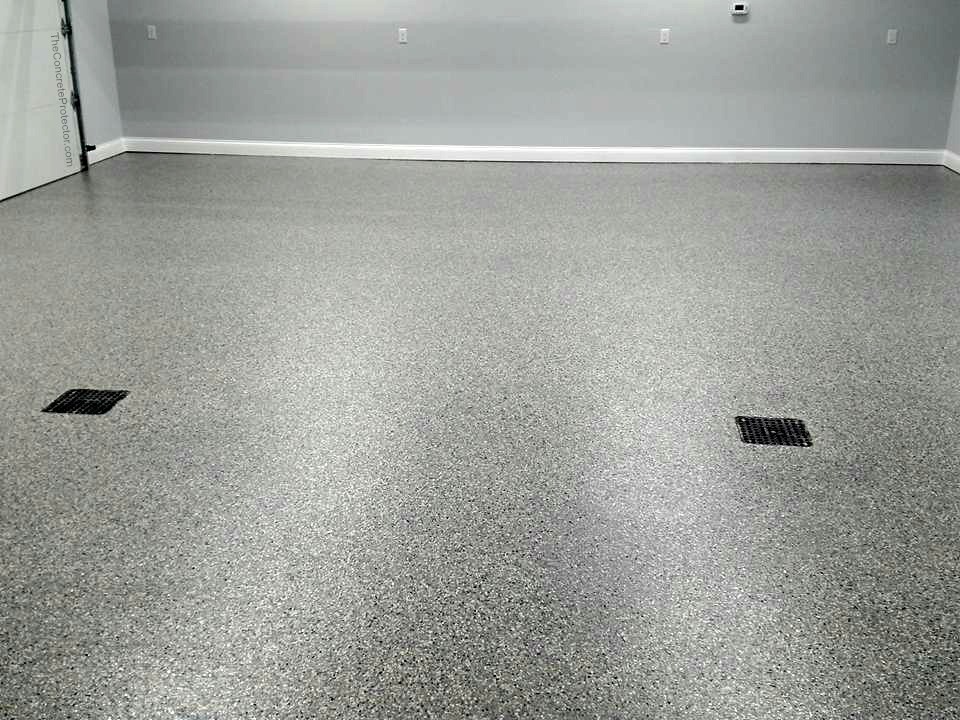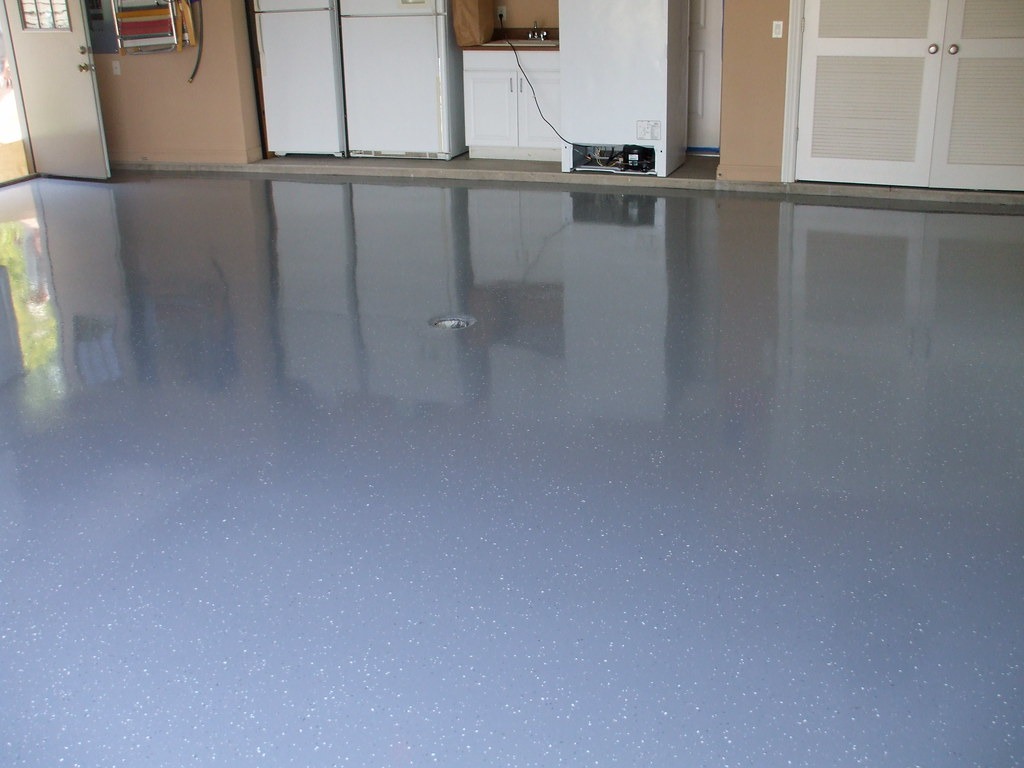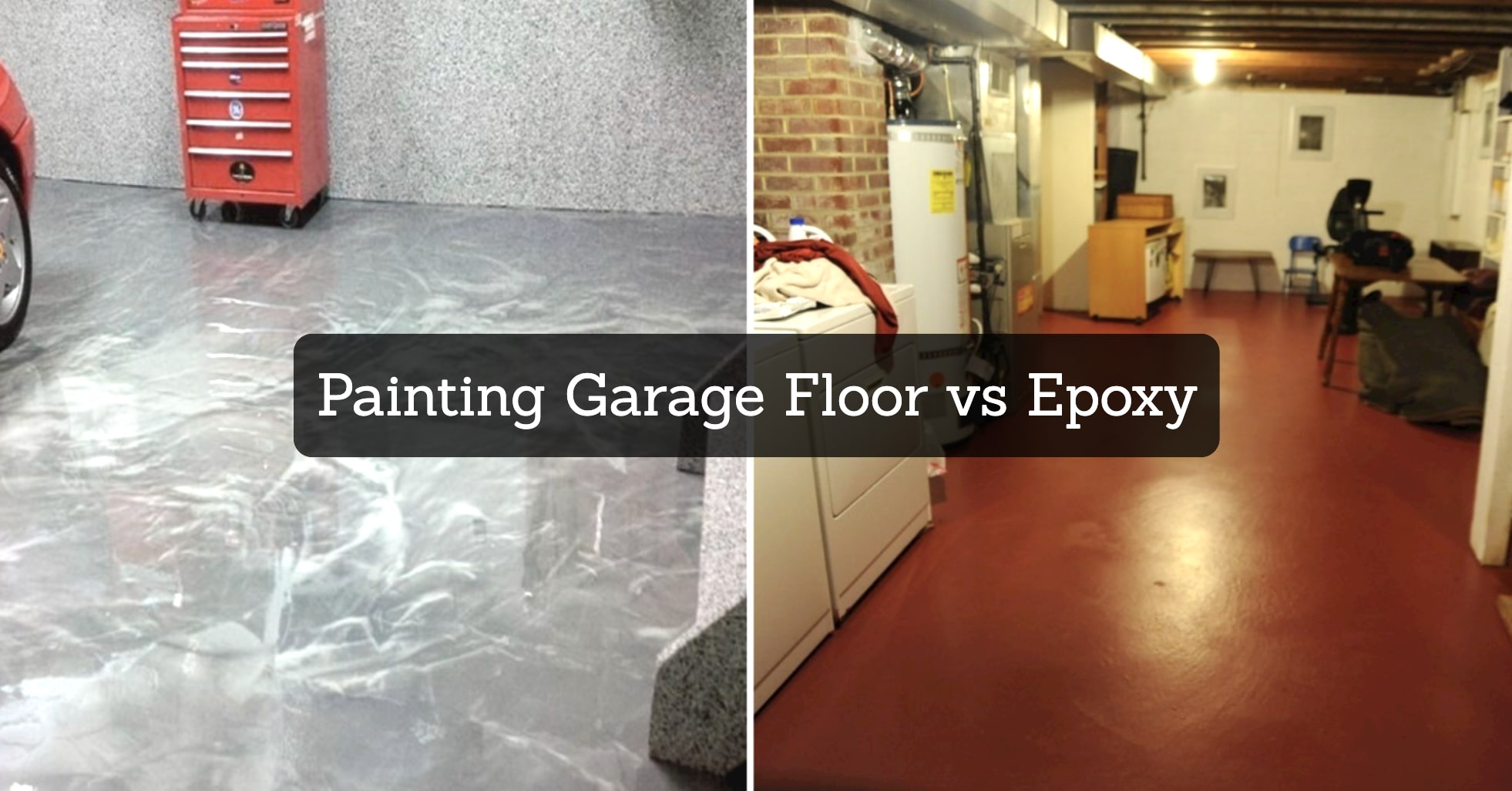Your garage floor endures a lot: spilled oil, tracked-in mud, scorching summer heat, and the constant weight of parked vehicles. With such wear and tear, transforming this utilitarian space into something aesthetically pleasing and functional might seem like a challenge.
But two options stand out: painting and epoxy coatings. Both provide a fresh look, but which one reigns supreme? Buckle up, as we delve into the detailed differences between painting your garage floor vs. coating it with epoxy.
Delve into the best black garage floor paint review to make an informed decision when considering the benefits of painting versus applying epoxy to your garage floor.
The Contenders
- Paint: A familiar DIY option, often latex-based, that applies a decorative layer to the concrete.
- Epoxy Coating: A resin-based system that bonds with the concrete, creating a thicker, more durable layer.
Round 1: Durability
Paint
Imagine a lightweight boxer, agile but lacking defense. This is paint’s durability. Sure, it can withstand occasional foot traffic, but in the high-intensity arena of your garage, it shows its weaknesses. Here’s the breakdown.

- Vulnerability: Chips, peels, and suffers from the dreaded hot tire pick-up, leaving unsightly and frustrating blemishes.
- Lifespan: A short sprint, lasting only a few months to a year in high-traffic areas before requiring touch-ups or complete reapplication.
- Traffic Tolerance: Best for light use like occasional car parking or storage. Think more Sunday driver than demolition derby.
You may also like: 7 Best Metal Look Paint for Garage
Epoxy
Now, picture a heavyweight champion – thick, resilient, and built to endure. That’s the durability of epoxy:
- Defense: Resists chipping, abrasion, and hot tire pick-up like a seasoned warrior deflecting blows. Say goodbye to unsightly peeling and hello to peace of mind.
- Endurance: A marathon runner, withstanding years of wear and tear with proper care. Once applied, it becomes your garage’s guardian for years to come.
- Traffic Tolerance: Handles anything your garage throws at it – cars, motorcycles, heavy tools, spilled chemicals – like a true champion.

The Verdict: When it comes to durability, epoxy stands tall as the champion. But if your garage sees light activity and budget is a priority, paint might be a contender.
Round 2: Aesthetics
Imagine your garage floor as a canvas. Both paint and epoxy offer ways to transform it, but the final masterpiece depends on your artistic vision and desired palette.
Paint
A painter’s dream, with a vast spectrum of colors and finishes to choose from. Matte, satin, or glossy — the choice is yours. Unleash your inner artist with DIY stencils or intricate patterns, creating a personalized touch that reflects your style.
But beware the brushstrokes of reality:
- Fading: Over time, the sun and garage elements can dull your vibrant colors, leaving a faded shadow of your initial masterpiece.
- Imperfections: Like painting over an uneven canvas, flaws in the concrete will show through, potentially detracting from the overall aesthetic.

Epoxy
Now, step into a world of high-gloss brilliance. Epoxy offers a reflective finish that expands the perceived size and brightness of your garage, creating a sleek and modern feel.
But don’t underestimate its customization potential:
- Flake it Up: Colored flakes or chips can be sprinkled into the epoxy, creating a unique textured look that adds depth and personality. Think terrazzo-inspired designs or playful pops of color.
- Logos and Designs: Feeling ambitious? With professional help, you can embed logos, personal designs, or even 3D effects into the epoxy, making your garage floor a true conversation starter.

The Verdict: Paint wins for sheer color variety and DIY customization. Epoxy shines with its high-gloss finish, unique textures, and potential for logos and designs. Ultimately, the “best” option depends on your desired aesthetic, whether you crave a colorful canvas or a modern masterpiece.
You may also like: 7 Best Wood Look Paint for Garage Doors
Round 3: Application & Cost
Paint
Think of painting your garage floor as a DIY project with a friendly price tag. Here’s the breakdown.
- DIY Delight: Grab your brush and roll up your sleeves! Paint requires minimal prep work, and readily available supplies from your local hardware store make it budget-friendly. Perfect for the handy homeowner who enjoys a challenge.
- Prep the Canvas: Don’t underestimate the importance of cleaning, degreasing, and patching your concrete floor. Skip this step, and your paint job might peel faster than a banana in the summer sun.
- Layer Upon Layer: Achieving a smooth, even finish requires multiple coats. Patience is key, as each coat needs drying time before the next.

Epoxy
Now, imagine transforming your garage floor with the expertise of a professional artist. Epoxy comes with a higher price tag, but here’s why.
- Pro Power: Leave it to the experts! Professional installation ensures meticulous surface preparation and proper application techniques, leading to a flawless, durable finish. Your peace of mind is worth its weight in epoxy chips.
- The Science of Sticking: Applying epoxy requires specific knowledge and tools. Think precise mixing, temperature control, and careful application – not exactly a weekend warrior’s project. Mistakes with epoxy can be costly and difficult to rectify.
- Long-Term Savings: While the initial cost stings, remember epoxy’s superior durability. You might save money in the long run by avoiding frequent repaints and touch-ups compared to paint’s shorter lifespan.

The Verdict: Paint wins for budget-conscious DIYers. Epoxy shines for those seeking professional application and long-term durability.
Round 4: Safety – Keeping Your Footing (and Sanity) Secure
Your garage floor shouldn’t be a treacherous ice rink waiting to happen. Both paint and epoxy can become slippery when wet, especially with oil spills or tracked-in snow. Let’s delve into the safety considerations for each contender.
Paint
- Slip and Slide Risk: Smooth painted surfaces can turn treacherous when wet. Consider adding textured paint additives for increased grip, especially near entrances and work areas. Rougher textures offer better traction, but remember, they might be harder to clean.
- Chemical Concerns: Some paints contain VOCs (volatile organic compounds) that can contribute to respiratory issues, particularly during application and drying. Opt for low-VOC or water-based paints to minimize health risks.

Epoxy
- Shiny and Slippery: The high-gloss finish of epoxy can be beautiful, but also hazardous when wet. Include non-slip additives or choose a slightly textured epoxy finish for enhanced traction. Remember, rougher textures might require more maintenance to keep clean.
- Chemical Caution: While generally resistant to chemicals, some epoxies might emit fumes during installation or curing. Ensure proper ventilation and follow safety precautions recommended by the manufacturer.

The Verdict: Both paint and epoxy require additional safety measures to prevent slips and falls. Consider implementing textured surfaces, non-slip additives, proper ventilation, and strategic mat placement for a safe and secure garage environment.
Round 5: Chemical Resistance – Protecting Your Garage from Fierce Fluids
Imagine your garage floor as a battlefield against spills and leaks. In this battle, chemical resistance is crucial. Let’s see how our contenders fare.
Paint
Picture a flimsy shield against a chemical onslaught. Paint offers limited resistance, making it vulnerable to:
- Household solvents: Cleaning products, degreasers, paint thinners – these can easily stain, soften, or even strip away paint, leaving unsightly blemishes and potential health hazards.
- Automotive fluids: Oils, antifreeze, brake fluid – forget about storing these on a painted floor. They’ll quickly degrade the paint, creating a sticky mess and potential environmental concerns.
- Harsh chemicals: Acids, alkalis, and other industrial-grade chemicals? Forget it! Paint offers minimal protection, putting your floor and potentially your health at risk.

Epoxy
Now, envision a sturdy barrier, deflecting chemical attacks with ease. Epoxy boasts superior chemical resistance, making it ideal for garages housing:
- Solvents and chemicals: Store away your cleaning products, degreasers, and even some paints with confidence. Epoxy can handle most common household and workshop solvents without flinching.
- Automotive fluids: Oil spills, antifreeze leaks, brake fluid drips – no problem! Epoxy forms a protective layer, making cleanup easier and preventing damage to your concrete floor.
- Even harsher chemicals: Depending on the epoxy type, you might even store acids, alkalis, and other industrial-grade chemicals with proper precautions. Consult the manufacturer for specific recommendations.

The Verdict: For garages exposed to chemicals, fluids, or spills, epoxy is the clear winner. However, consider the specific chemicals you’ll encounter and choose the appropriate epoxy type based on its resistance level.
You may also like: 7 Best Gas Pressure Washers for Garage
Round 6: Environmental Impact – Weighing the Green Footprint of Your Garage Floor
In today’s eco-conscious world, even garage floor makeovers must consider their environmental impact. Let’s compare the contenders.
Paint
- VOC Villains: Traditional paints often contain VOCs (volatile organic compounds) that evaporate during application and drying, contributing to air pollution and potential health concerns. Choose low-VOC or water-based paints to minimize your environmental footprint.
- Disposal Dilemmas: Leftover paint and paint-soaked materials require proper disposal, which can be tricky and potentially contribute to hazardous waste streams. Explore recycling programs for paint cans and consider using leftover paint for small projects instead of discarding it.

Epoxy
- Resin Reality: Epoxy is a petroleum-based product, contributing to the demand for fossil fuels during its production. However, its durability means fewer reapplications are needed, potentially reducing the overall environmental impact compared to frequently repainted floors.
- Fume Fallout: Some epoxies emit fumes during installation and curing, containing VOCs and other potentially harmful chemicals. Ensure proper ventilation and follow safety precautions recommended by the manufacturer to minimize your environmental and health impact.
- Disposal Challenges: Similar to paint, leftover epoxy and application materials require proper disposal, often classified as hazardous waste. Research local disposal options and consider responsible disposal methods to minimize environmental harm.

The Verdict: Both paint and epoxy have environmental considerations. Low-VOC or water-based paints might be a good choice for budget-conscious DIYers.
However, for long-term durability and potentially lower environmental impact in the long run, professionally applied, high-quality epoxy with responsible disposal methods can be a more eco-friendly option.
Round 7: Maintenance – The Battle for a Spotless Garage Floor
Your garage floor endures spills, dirt, and wear and tear. But let’s face it, nobody enjoys spending hours scrubbing it. So, which contender offers the easier upkeep?
Paint
Imagine constantly chasing after dust bunnies and battling stubborn stains. Paint requires frequent cleaning and touch-ups:
- Scrub-a-dub-dub: Regular sweeping, mopping, and degreasing are essential to keep paint looking its best. Prepare to invest time and elbow grease, especially in high-traffic areas.
- Stain Battles: Spills and leaks can leave unsightly blemishes on paint. Removing them might require harsh chemicals or even sanding, potentially damaging the paint further.
- Touch-Up Troubles: As paint wears or chips, frequent touch-ups are necessary to maintain a cohesive appearance. This translates to more time and materials invested in keeping your floor looking presentable.

Epoxy
Picture a non-porous shield, repelling dirt and making cleaning a breeze:
- Wipe and Shine: Due to its non-porous nature, epoxy is generally easier to clean. Regular sweeping and occasional mopping with a damp cloth usually suffice. Say goodbye to the endless scrubbing struggle!
- Stain Resistance: Spills and leaks bead up on epoxy, making them easier to wipe away before they set in. However, stubborn chemicals might require specific cleaning solutions to avoid damaging the epoxy.
- Low-Maintenance Appeal: Once cured, epoxy requires minimal maintenance compared to paint. No more frequent touch-ups, just enjoy the long-lasting beauty of your floor.

The Verdict: Epoxy wins for overall low-maintenance. However, if budget dictates a DIY paint job, be prepared to invest more time and effort in cleaning and upkeep.
Round 8: Heat Resistance – Keeping Your Garage Cool Under Pressure
Your garage isn’t just a haven for your car; it can be a workshop, storage space, or even a home gym. But when the summer sun heats things up, can your floor handle the pressure? Here’s how our contenders fare in the heat.
Paint
Think of paint as a thin layer of clothing. Its heat resistance varies greatly depending on the type:
- Latex Lightweight: Like a cotton T-shirt, latex paints soften and blister under extreme heat, making them unsuitable for scorching garages. Stick to these for mild climates or cooler areas within your garage.
- Acrylic All-Rounder: Imagine a breathable athletic shirt. Acrylic paints offer moderate heat resistance, handling temperatures around 150°F. Consider these for garages with occasional hot days but not sustained heat.
- High-Temperature Hero: Picture a heat-resistant oven mitt. Specialty high-temperature paints can withstand up to 250°F, making them ideal for garages facing intense summer heat.

Epoxy
Now, imagine a thick, heat-resistant shield. Epoxy generally offers good heat resistance:
- Standard Strength: Most epoxies can handle temperatures up to 200°F, ideal for most garages. Think of it as a sturdy winter coat for your floor.
- High-Temp Champions: Some industrial-grade epoxies can withstand even higher temperatures, exceeding 300°F. Perfect for garages used for welding, metalworking, or other high-heat activities.

The Verdict: When facing extreme heat, high-temperature paint or specially formulated epoxy are your best bets. However, for mild climates or controlled heat exposure, acrylic paint or standard epoxy might suffice.
Consider your garage’s typical temperature range, potential heat sources, and budget to choose the champion against the heat.
Round 9: Crack Repair – Filling the Gaps in Your Garage Fortress
Your garage floor might bear the scars of time and wear, showing its battle wounds in the form of cracks. But fear not, for both paint and epoxy offer solutions to mend these fractures and restore your floor’s integrity. Let’s explore their crack-taming abilities.
Paint
Think of paint as a thin bandage. While it can’t heal cracks, it can offer some cosmetic camouflage:
- Hairline Heroes: For hairline cracks (less than 1/16 inch wide), paint might fill them in temporarily, hiding them from plain sight. But remember, this is like covering a wound with a Band-Aid; the crack itself remains unaddressed and might reappear through the paint over time.
- Larger Lesions: Forget about using paint to fix larger cracks (exceeding 1/16 inch). They’ll show through the paint, potentially looking worse and collecting dirt and debris that can further damage the concrete.

Epoxy
Now, imagine epoxy as a powerful sealant. While not a miracle cure, it can tackle crack repair quite effectively:
- Minor Menders: Cracks up to 1/8 inch wide can be filled and smoothed over during the epoxy application process. This creates a seamless surface, hiding the crack and preventing further damage.
- Beyond Band-Aids: But hold on, epoxy isn’t a superhero when it comes to major cracks. Cracks wider than 1/8 inch or those exhibiting movement require professional repair before applying epoxy. Improper filling of large cracks can trap moisture and worsen the problem.

The Verdict: Paint wins for hiding hairline cracks without professional intervention. However, for larger cracks or long-lasting repair, epoxy takes the crown with its filling capabilities.
Round 10: DIY Friendliness – Building Your Dream Garage Floor, Yourself?
Imagine wielding a brush or trowel, transforming your garage floor into a masterpiece. But before you embark on this DIY adventure, consider the difficulty level of each contender.
Paint
Picture yourself as a budding artist, armed with a paintbrush and basic tools. Painting your garage floor can be:
- DIY Delight: Latex paints are generally beginner-friendly, requiring minimal surface prep and readily available supplies from your local hardware store. Think patching cracks, cleaning the concrete, and rolling on even coats – a project most handy homeowners can tackle.
- Forgiving Canvas: Made a mistake? Relax! Unlike epoxy, paint allows for easier fixing. Simply sand off the imperfection and repaint the area. Remember, practice makes perfect, and a few test runs on a hidden patch can boost your confidence.

Epoxy
Now, envision yourself as a master builder, wielding trowels and mixing precise ratios. Applying epoxy is:
- Advanced DIY Challenge: Forget the paintbrush; epoxy requires meticulous surface preparation, including grinding, cleaning, and ensuring proper temperature and humidity. You’ll also need specific tools and knowledge of mixing ratios and application techniques. It’s like building a complex model, not just coloring in the lines.
- Mistakes are Costly: Unlike paint, fixing epoxy mistakes can be challenging and expensive. Improper application can lead to uneven surfaces, bubbles, or worse – having to start over entirely. Consider professional help if you’re unsure of your DIY skills.

The Verdict: Painting is the clear winner for beginner DIYers. It’s affordable, forgiving, and requires readily available tools. However, if you’re confident, meticulous, and comfortable with complex projects, epoxy can be a rewarding DIY challenge.
Round 11: Long-Term Value – Counting the Pennies for Your Garage Floor’s Future
When it comes to your garage floor, the price tag isn’t just about upfront costs. Consider the long-term value each contender offers:
Paint
Think of it as a budget-friendly starter car. Paint boasts a lower initial cost, making it easy on the wallet. But remember, cheap doesn’t always mean economical:
- Frequent Flyer: The lower upfront cost comes with the trade-off of more frequent maintenance and touch-ups. Peeling, chipping, and fading paint require repainting, adding to the overall cost over time.
- Lifespan Limitations: Paint generally lasts 1-3 years before needing major touch-ups or complete reapplication. Consider this lifespan against your desired aesthetic longevity. If you plan to frequently update your garage design, paint’s shorter lifespan might be suitable.

You may also like: 7 Best Laminate Flooring for Garage Reviews
Epoxy
Imagine it as a reliable, high-performance vehicle. Epoxy’s initial cost is higher, but its value shines in the long run:
- Durability Dividend: Epoxy’s superior durability translates to a longer lifespan, often lasting 10-15 years with proper care. This means fewer reapplications, ultimately saving you money compared to frequently repainting with cheaper materials.
- Aesthetics that Last: Unlike paint, epoxy’s high-gloss finish and potential for customization (colored flakes, logos) resist fading and wear, maintaining its premium look for years to come.

The Verdict: If upfront cost is your primary concern and you’re flexible with aesthetics, paint offers a budget-friendly option. However, for long-term value, durability, and a lasting high-end look, epoxy’s higher upfront cost might be a wiser investment.
After all, there’s no clear winner, as the best choice depends on your priorities and budget. For a quick, budget-friendly makeover, paint might suffice. However, if you prioritize durability, chemical resistance, and a high-end look, epoxy is the undisputed champion. Ultimately, weigh your needs and choose the option that best transforms your garage into a space you’ll enjoy using.

